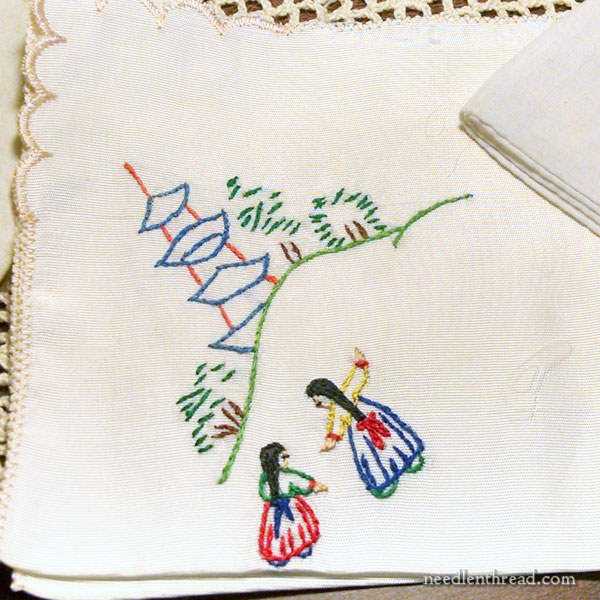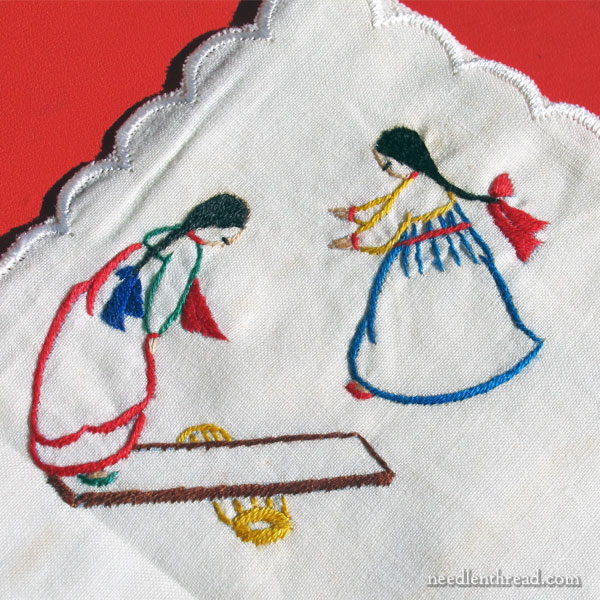Continuing with little historical stories about embroidery, I thought I’d end the week where we began it: with the embroidered handkerchief.
Remember the hand embroidered handkerchiefs we examined earlier this week, that feature embroidered figures?
I thought at first that they were both objects of the tourist trade. It turns out that one is, one isn’t. Panama Pamela is the tourist.
But the little Korean girls on the teeter totter are not. Instead, they’re proof that amazing things can be accomplished with a few embroidery stitches.

I received a lot of feedback about the handkerchiefs I wrote about on Monday.
I found out that Panama Pamela is dressed in the native Pollera of Panama – you can see a good image of the Pollera here on Pinterest.
I found out that the little Korean teeter totter girls are well-known among handkerchief collectors and that they’ve been around since about 1963, just after the Korean War.
They’re not always teeter-tottering, though. Sometimes, they’re playing other games. Sometimes, they’re walking together, like the two on the hanky in the photo above, which was sent in by Judy.
It’s always the two of them, embroidered in their bright colors.
The hankies were stitched by the hands of Korean women in post-war Korea, who participated in a cottage industry known as Operation Hanky, established by Fr. Al Schwartz to raise funds to help the poor of Korea.
At its peak, the operation employed over 3,300 women, either embroidering in their homes, doing the finish work on the hankies, or managing the mailings for Korean Relief. Fr. Schwartz’s charitable outreach program involved soliciting donations by including a hand embroidered handkerchief or scarf in the mailings. In 1964 alone, over one million embroidered items left Korea in solicitation envelopes headed for the US.
In less than two years, the results of the fundraising were impressive: one hospital, an orphanage, two dispensaries, an old-age home, a boy’s technical school, a day care center, a cooperative farm program established, and funds granted to over thirty hospitals, to leper colonies, to orphanages, schools and other charitable works throughout Korea.

So this is where the little teeter-totter girls come from, and that’s the story they tell. It puts a whole new spin on the whimsical fun they’re having, doesn’t it?
If you’re interested in reading the details about the history of this successful cottage industry that did so much for an impoverished, war-torn country, here are a couple good articles:
Operation Hanky: The Uncommon Story behind a Common Hanky – this article, on the blog The Literate Quilter, includes photos of the fundraising letters and flyers that went out with the hankies.
The Biography of Aloysius Schwartz on the Ramon Magsaysay Award Foundation website, an award foundation that honors “greatness of spirit and transformation leadership in Asia.”
See how much good can be done with needle and thread?
Enjoy your weekend!







Another so very interesting post Mary. Thank you. Wonderful history.
thank you for sharing! operation hanky is such a wonderful story and I would never have known the meaning behind these very special embroideries.
That’s a beautiful story – too bad people don’t use hankies anymore!
Dear Mary
I’v just read the detailed account of Fr. Al Schwartz, from the above link. What a lovely story and what a wonderful way to make money through embroidered handkerchiefs to help a war torn country and what a great achievement to have been able to be involved in a redevelopment program of Korea. As you say so much was achieved through needle and thread. Thanks for sharing Operation Hanky with us and the history of Fr. Al Schwartz and his mission in Korea.
Regards Anita Simmance
So glad you are spreading the story of these hankys!
How fascinating.
An armistice was signed to end armed conflict in Korea in 1953, but that “war” never has ended officially — a big reason for the DMZ. By 1963, we had sent military advisors to Vietnam and turned our thoughts there.
Thank you for this wonderful story! I just love knowing the history of things like this. To some, these are just old pieces of fabric to be discarded. To me, its a fascinating look at life, history and the human spirit.
I have not seen the hanky at the top ! I am glad my research is being found and shared. This is a story that needs to be known. Nancy
Amazing history of the little hankies. Another instance of women keeping bodies and souls together with needle ‘n’ thread.
Thank you, Mary! The wonderful story with its sad origins makes the delightful embroidery all the more precious.
Mary una como un pedazo de tela y aguja ,pudo levantar en algo un pais
genial idea
gracias
lidia
i am so interested to know this. I have a little teeter totter hanky that my grandmother gave me in the 60s. I knew she didn’t embroider it, but it looked handmade. Thank you for sharing the story!
I love that history, there is good to remember and inspire us, thanks for sharing.
Thanks for another interesting article Mary. I so enjoy reading your blog every day. 🙂
The Roman Catholic Church is in the process of canonization of Fr. Al, that is, of declaring him a saint.
My grandmother gave me this hanky when I was a little girl (I’m 50 now) and neither my mom nor I knew where it came from. Doing a little research I came across your blog. So very interesting to finally know the story. Thank you!
I just bought a collection of vintage handkerchiefs and it included 2 of the see-saw girls in brand-new condition – in the bags! I saw the Made in Korea sticker and it’s so fun to find the exact hankie on your site.